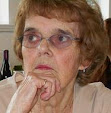I see in the Times Obits today that Eva Petulengro has died, aged 85. As this is 6 years younger than me then the figure who I heard of regularly during my childhood was obviously her mother - also Eva Petulengro - quite a well-known figure in the 'old days'.
The family had a history of being Clairvoyants and reading through the Obituary today made me think about the 'old days'.
My father always assured us all that my Mother had Romany blood -she always played it down although never actually denying it. I am not suggesting they were related to one another but it is interesting to read that Romany families were frequently found in the Lincolnshire Fens, which is where my mother came from. As a young woman, looking at photographs that I have of her, there is no doubt she was a very beautiful young woman. Also she was black-haired as are most Romanies.
My Dad spoke often of visiting her Grandfather, who lived on Bardney Common in a Caravan and who my father insisted kept his Sunday Joint in an enamel bucket under the van with a sod of grass for a bucket-lid!
I don't know - and I suppose never will know - the truth of the matter and to me it doesn't really matter in the slightest. All I do know is that Mother wished me to be called Rebecca, but considering the political 'climate' in the World at the time (1932) and the association of the name in both Jewish and Romany communities my parents decided against it and called me Patricia Ellen instead.
Now, as Romany and Traveller communities are trekking through Wensleydale this week on their way to the Appleby Horse Fair which begins next week-end (and holding up traffic a bit), and now today reading of the death of Eva Petulengro, I recalled the old days, when country folk (as we were) did rather believe in such things; how she grew up in a traditional Vardo having a Romany mother and a gorger (non-Romany) father and how her father embraced the traditional life of the Romanies; how the family always travelled in a convoy of three wagons, each drawn by black and white cob horses, the wagons painted red and gold; it does make me wonder. My mother's favourite novel, throughout her life, was a book called "Red Wagon" (I believe by Lady Eleanor Smith).
The obit speaks of their food being wild mushrooms and illegally bagged pheasant and partridge (and hotchi - hedgehogs - baked in clay (ugh!) and tells of male members of the family carving clothes pegs from lengths of willow and the woman tying them in bundles and selling them in the villages of the Lincolnshire and East Anglian Fens. (these were always the pegs of my childhood)
And one final note about how Dads toughened up their kids to suffer what were definitely the 'slings and arrows of outrageous fortune' in those days:
Her Dad would encourage her to jump from the steps of the caravan into his arms and then at the last minute step out of the way so that she fell on her face in the mud. (Can't imagine any child not being wise to that after trying it once).

